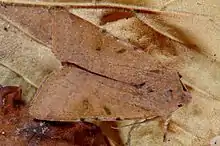Agrochola lychnidis
Agrochola lychnidis, the beaded chestnut, is a moth of the family Noctuidae. The species was first described by Michael Denis and Ignaz Schiffermüller in 1775. It is distributed throughout the whole of Europe from Ireland to the Urals. It also occurs in western North Africa and Asia Minor.
| Agrochola lychnidis | |
|---|---|
 | |
| Scientific classification | |
| Kingdom: | Animalia |
| Phylum: | Arthropoda |
| Class: | Insecta |
| Order: | Lepidoptera |
| Superfamily: | Noctuoidea |
| Family: | Noctuidae |
| Genus: | Agrochola |
| Species: | A. lychnidis |
| Binomial name | |
| Agrochola lychnidis (Denis & Schiffermüller, 1775) | |
The wingspan is 30–35 mm. Forewing bright rufous or reddish ochreous with the veins paler, often dusted with darker; inner and outer lines double, dark, with the centre rufous, often very faint, but always marked by black spots on costa; submarginal line preceded by a row of dark lunules between the veins and by a dark bar at costa; median shade distinct; stigmata blackish, distinct, especially the narrow oblique orbicular; hindwing dark grey, the fringe rufous. This species varies in colour exceedingly; the brighter rufous specimens, with pale veins, represent typical lychnidis F.; the duller brownish forms, also with pale veins, are pistacina F.; - rubetra Esper the bright rufous unicolorous form with all markings indistinct, and the costal edge often conspicuously white at middle, of which ferrea Haw. is an offshoot, having only the 4 costal blotches and the stigmata dark; the paler, reddish ochreous, unicolorous form is obsoleta Tutt; of the forms without red colouring, serina Esp. has the markings plain, while in pallida Tutt they are obscure, the ground colour being greyish ochreous or yellowish;of the brownish rufous or brownish grey forms, brunnea Tutt is a more sombre form than pistacina without pale nervures; canaria Esp. is a form in which the lines and veins and edges of the stigmata are dull fulvous and the ground colour blackish, as a rule much darker in the male than in the female; dark specimens like these also occur but with the light shades only dull brown and the dark interspaces not so black; caerulescens Calb. from Italy, is a bluish or lilac grey insect; this form also occurs in Asia Minor; a large number of examples from Amasia, especially females, agree exactly, while the rest, mainly males become greyish luteous, as in serina, with the markings varying in intensity".[1]

Biology
The larvae are polyphagous feeding on low plants when small, later consuming the leaves of various trees and shrubs[2] (Prunus, Salix, Achillea, Ranunculus etc.).
The moths fly in September and October.
References
- Seitz, A. Ed., 1914 Die Großschmetterlinge der Erde, Verlag Alfred Kernen, Stuttgart Band 3: Abt. 1, Die Großschmetterlinge des palaearktischen Faunengebietes, Die palaearktischen eulenartigen Nachtfalter, 1914
- Robinson, Gaden S.; Ackery, Phillip R.; Kitching, Ian J.; Beccaloni, George W. & Hernández, Luis M. (2010). "Search the database - introduction and help". HOSTS - A Database of the World's Lepidopteran Hostplants. Natural History Museum, London.
External links
| Wikimedia Commons has media related to Agrochola lychnidis. |
- Kimber, Ian. "73.186 BF2267 Beaded Chestnut Agrochola lychnidis ([Denis & Schiffermüller], 1775)". UKMoths. Retrieved 22 January 2021.
- Savela, Markku, ed. (August 29, 2020). "Agrochola lychnidis (Denis & Schiffermüller, 1775)". Lepidoptera and Some Other Life Forms. Retrieved January 22, 2021. Taxonomy
- "Agrochola lychnidis (Denis & Schiffermüller, 1775)". Lepidoptera and Their Ecology. Retrieved January 22, 2021.
- Fauna Europaea
- "09565 Agrochola lychnidis ([Denis & Schiffermüller], 1775) - Veränderliche Herbsteule". Lepiforum e. V. Retrieved January 22, 2021. (in German)
- "Variabele herfstuil Agrochola lychnidis". De Vlinderstichting. Retrieved January 22, 2021. (in Dutch)